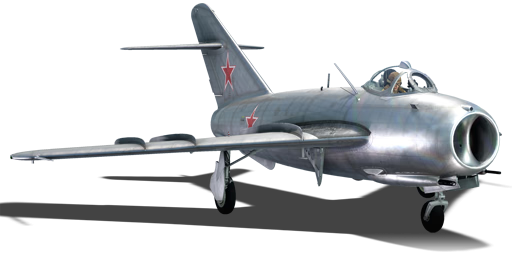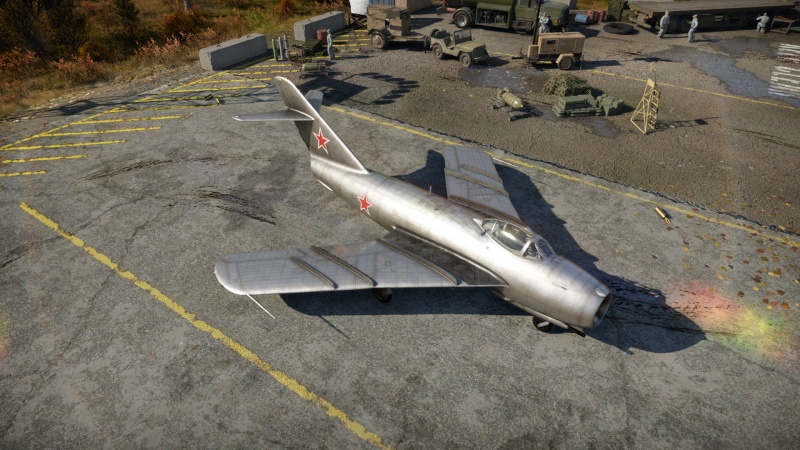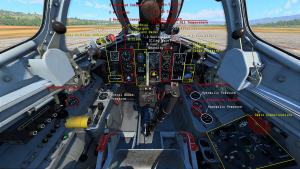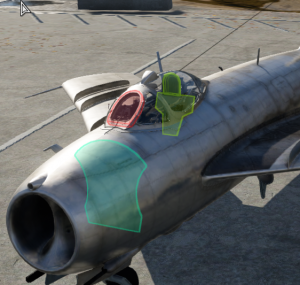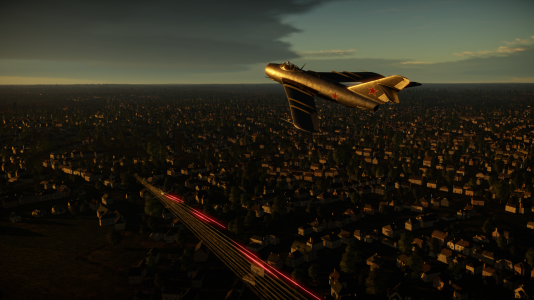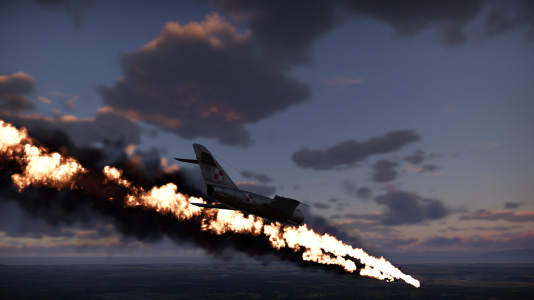MiG-17
| This page is about the Soviet jet fighter MiG-17. For other versions, see MiG-17 (Family). |
Contents
Description
Almost immediately after the MiG-15 entered service, the developement of a successor was already underway. Initially called the MiG-15bis-45, the new aircraft was to rectify one major flaw in the MiG-15 design: The severe vibrations and near-loss of controls when approaching Mach 1. To fix these problems, a new wing shape, airfoil form, and tailplane design were introduced. The results of heavy wind tunnel testing and prototyping by TsAGI resulted in the aforementioned changes exceeding all expectations, and as a result, the MiG-17 would establish itself in history as one of, if not the most, successful transsonic fighter aircraft until the advent of true supersonic airframes such as the MiG-19 and F-100. The MiG-17 was given a trial by fire during the Vietnam War, where it was faced against the far more advanced and newer American fighter-bombers, such as the F-4 Phantom II and the F-105 Thunderchief, which to everyone's surprise, were regularly beaten by the MiG-17 in dogfights due to the latter's incredible agility and small size making it hard to hit, and also because early variants of the F4 Phantom II deployed in Vietnam lacked any form of internal guns, an issue the MiG-17 did not suffer from. The MiG-17 became one of the most widely serving fighter aircraft in the world at the time, and as such, garnered many famous nicknames from around the world; with a NATO reporting name of Fresco, but also affectionately called "én bạc" (Silver Swallow) in North Vietnam, and "Barmil" (Barrel) among some Egyptian pilots, in addition to its standardized names from the license produced variants, Shenyang J-5 (歼-5) in China, S-104 in Czechoslovakia, and the PZL-Mielec Lim-5 in Poland.
The MiG-17, introduced in Update 1.55 "Royal Armour", is a direct upgrade in development over the previous MiG-15. The MiG-17 does not upgrade much (if at all) in the energy fighting, top speed, or manoeuvring departments. However, the new wing and tailplane design rectify one of the biggest issues in the older MiG-15: the terrible compression nearing transsonic speeds. The MiG-17 still has compression issues at high speeds, although the compression ceiling has been lifted far higher than its predecessor, allowing it to engage in faster combat manoeuvres than the MiG-15. One must however be very wary of advanced air-to-air missiles when flying this aircraft, as when uptiered, the player will regularly be faced with aircraft carrying the all-aspect AIM-9L and R-60M such as the A-10A and the Su-25, which are an almost guaranteed death sentence to the MiG-17.
General info
Flight performance
The MiG-17 is a high-subsonic fighter aircraft, it retained the Klimov VK-1 engine that was used by its predecessor, the MiG-15bis. Although the plane is heavier, its level speed performance is slightly improved due to aerodynamic improvements such as a new thinner and more highly swept wing and tailplane. The level speed at sea level is 1,121 km/h, very close to its structural speed limit and over 40 km/h higher than the MiG-15, that makes it very comparable with other jets like the F-86F series. The climb rate performance remained the same: with full fuel tanks it is 50 m/s at very low altitude and 35 m/s above 5,000 m altitude, which puts it on par with the Sabre series but is significantly worse than the British Hawker Hunter F.1 or French Super Mystère B2 with an afterburner that can get to 6,000 m altitude in over two minutes. Since the MiG-17 is heavier its thrust to weight ratio is decreased and it affects its acceleration at low and medium speeds, but at higher speed due to lower drag and more swept wings it is slightly better. Prolonged usage of maximum power in this plane may cause its engine to overheat after 10 minutes of flight, when the plane is cruising and not in any combat situation it is recommended to reduce it to 95% or 90% which does not have any operation limit.
The dogfighting capabilities are very close to its precursor, while it is over 200 kg heavier its wing area is also increased, so the wing loading is slightly lower, at low and medium speed its turn rate is slightly worse, but once the plane reaches 750 km/h it gets better. However it still suffers to some extent from compressibility issues near transonic speed. The MiG-17 is still a very dangerous foe to the Sabre series and many other jet fighters, one of its main strengths is performance in vertical manoeuvres. It is also capable of outturning the Sabre, the Super Mystère or Hunter so facing them should not be a problem. Its roll rate is practically the same as the MiG-15bis, mediocre at low and medium speed and it can get very bad above 900 km/h. It is very close to 100 °/s at 600 km/h IAS and lowers to ~50 °/s upon reaching 900 km/h IAS. The airbrake is the same: it can help slow down to the speed range where its turn rate is the best. Flaps also have the same speed limit, over 600 km/h in take-off position and 450 km/h for landing, which is quite high, just like its landing gear, which can come very handy when the plane is landing after having taken some damage.
With full-real controls it is very pleasant to fly, does not have any stability issues at any speed and it is very easy to aim. Its nose will keep dropping until it reaches 850 km/h IAS so it might need some positive pitch trimming below that speed, above that it should be trimmed from -1% to 3%, depending on how fast it is. The stalling characteristics are quite forgiving, after reaching the maximum angle of attack it will not start rolling to any side immediately, but its speed will keep decreasing very fast.
| Characteristics | Max Speed (km/h at 2,000 m) |
Max altitude (metres) |
Turn time (seconds) |
Rate of climb (metres/second) |
Take-off run (metres) | |||
|---|---|---|---|---|---|---|---|---|
| AB | RB | AB | RB | AB | RB | |||
| Stock | 1,091 | 1,061 | 15500 | 22.2 | 23.2 | 41.2 | 39.1 | 475 |
| Upgraded | 1,128 | 1,114 | 21.2 | 21.5 | 59.9 | 50.0 | ||
Details
| Features | |||||
|---|---|---|---|---|---|
| Combat flaps | Take-off flaps | Landing flaps | Air brakes | Arrestor gear | Drogue chute |
| X | ✓ | ✓ | ✓ | X | X |
| Limits | ||||||
|---|---|---|---|---|---|---|
| Wings (km/h) | Gear (km/h) | Flaps (km/h) | Max Static G | |||
| Combat | Take-off | Landing | + | - | ||
| 1,150 | 450 | - | 598 | 450 | ~12 | ~5 |
| Optimal velocities (km/h) | |||
|---|---|---|---|
| Ailerons | Rudder | Elevators | Radiator |
| < 600 | < 700 | < 750 | - |
Engine performance
| Engine | Aircraft mass | |||||
|---|---|---|---|---|---|---|
| Engine name | Number | Basic mass | Wing loading (full fuel) | |||
| Klimov VK-1 | 1 | 3,958 kg | 227 kg/m2 | |||
| Engine characteristics | Mass with fuel (no weapons load) | Max Takeoff Weight | ||||
| Weight (each) | Type | 8m fuel | 20m fuel | 29m fuel | ||
| 892 kg | Centrifugal-flow turbojet | 4,310 kg | 4,755 kg | 5,130 kg | 5,485 kg | |
| Maximum engine thrust @ 0 m (RB/SB) | Thrust to weight ratio @ 0 m (100%) | |||||
| Condition | 100% | WEP | 8m fuel | 20m fuel | 29m fuel | MTOW |
| Stationary | 2,450 kgf | N/A | 0.57 | 0.52 | 0.48 | 0.45 |
| Optimal | 2,450 kgf (0 km/h) |
N/A | 0.57 | 0.52 | 0.48 | 0.45 |
Survivability and armour
- 60 mm Bulletproof glass in cockpit front.
- 16 mm Steel plates behind the pilot.
- 10 mm Steel plate in the nose.
This armour layout lets the pilot be secured while leaving the tail and wings unprotected.
Modifications and economy
It is recommended to prioritize performance modification and 37 mm belts over other modifications.
Armaments
Offensive armament
The MiG-17 is armed with:
- 1 x 37 mm N-37D cannon, nose-mounted (40 rpg)
- 2 x 23 mm NR-23 cannons, nose-mounted (80 rpg = 160 total)
Suspended armament
The MiG-17 can be outfitted with the following ordnance:
- Without load
- 2 x 250 kg OFAB-250sv bombs (500 kg total)
- 16 x S-5K rockets
- 16 x S-5M rockets
- 2 x S-21 rockets
Usage in battles
The MiG-17 should be played like its predecessors, the MiG-15s. In 1v1 situations, the -17 will easily win if played correctly, and due to its superior flight characteristics it is easier to win fights against multiple enemies. You have the upper hand in the initial dogfight, as your great turn will allow you to get on their 6 without much difficulty. However, in a prolonged engagement the chances of you losing increase due to your heavier weight and good, yet not spectacular energy retention. If the player is uncomfortable with dogfighting, the MiG-17 can also be a very effective boom-and-zoom fighter.
Pros and cons
Pros:
- Excellent acceleration and speed in dives
- Excellent climb rate, almost same as the MiG-15bis
- Guns will tear even the heaviest of bombers into shreds with an accurate burst
- Very good manoeuvrability at low to medium speeds
- More manoeuvrable at high speeds than the MiG-15s
- Excellent energy retention, but still loses some speed when turning hard
- If you airbrake enemies should struggle to make you overshoot
- Performs well at altitude when compared to aircraft such as the F-86F Sabres and the Hunter F.1
- Can safely reach a speed of 1,150 km/h (IAS) and up to Mach 1.10 when diving
- Hard to break wings in a turn without rolling
- Very similar to the MiG-15bis, meaning similar playstyles
Cons:
- Roll rate is not on par with others in this tier
- Armament difficult to use (low velocities, low ammo and two different trajectories)
- Mediocre acceleration in speeds between 800 - 1,100 km/h
- Acceleration and energy retention makes defensive fighting harder as you might overshoot targets
- Poor forward visibility in Simulator, as a large canopy frame and the gunsight block the top and bottom
- Lacks radar rangefinder for the gyro sight
- Engine eventually might overheat when operated over 96% throttle
- Does not handle damage very well
History
The Korean war showed that the MiG-15 and MiG-15bis fighters were able to battle any aerial opponent at least on equal terms. The MiG-17 was a further development of the MiG-15 design that had proven itself so well. It was decided to increase the aircraft's speed by increasing the sweep of the wing and the fuselage being lengthened to maintain the centre of gravity. The MiG-15 and MiG-17 show almost no differences at first glance. The prototype of the MiG-17 was even called the MiG-15bis45. However, only the frontal parts of the fuselage are the same, from the air intake to the wing, if you don't count the landing headlight that had been moved to the left wing and some minor details.
These aircraft are different in every other way. It is easy to see the main differences when you look from above. By comparing the side profiles, you can see that in addition to the difference in fuselage length there are differences in the tail fin and an additional ventral fin which allows you to immediately tell the MiG-17 apart from the MiG-15. The upper part of the fins and the rudders of the aircraft are different, the juncture between the fin and the stabilizer fin also differs, but this can only be seen close up. The wing sweep of the stabilizer fin was also increased and there were also changes to elevators. The air brakes also differ in shape and size. The depth of the housing was decreased, so a cigar-shaped cowl was created to hide the cylinder. There were very significant changes to the wing. Apart from an increased wing sweep, a leading edge break appeared and the tips became rounder, which helps differentiate the aircraft when looking at them from above or below. While the MiG-15 had two aerodynamic ridges on the top surface of its wings, the MiG-17 had three.
The change in the shape of the wing led to appropriate changes in the construction of the flaps. The new geometry of the main landing gear legs required for the cover to be altered. The structure of the canopy also saw some changes. However, the first versions of the MiG-17 had the same canopies as the MiG-15bis. Apart from changes to the design of the canopy framing (which is not actually that noticeable from afar), a rear-view mirror was introduced that would allow the aircraft to be recognized from further away. There were no significant changes to the cockpit. Overall, the MiG-17 looks even more aesthetically pleasing and streamlined than its predecessor.
Media
- Skins
- Images
- Videos
See also
- Aircraft of comparable role, configuration and era
External links
| Mikoyan-Gurevich Design Bureau (Микоя́н и Гуре́вич Опытное конструкторское бюро) | |
|---|---|
| Fighters | MiG-3-15 · MiG-3-15 (BK) · MiG-3-34 |
| I-225 | |
| Jet fighters | MiG-9 · MiG-9 (l) |
| MiG-15 · MiG-15bis · MiG-15bis ISH | |
| MiG-17 | |
| MiG-19PT | |
| MiG-21F-13 · MiG-21PFM · MiG-21S (R-13-300) · MiG-21SMT · MiG-21bis | |
| MiG-23M · MiG-23ML · MiG-23MLD | |
| MiG-27M · MiG-27K | |
| MiG-29 · MiG-29SMT | |
| Export/Licensed | ␗MiG-9 · ␗MiG-9 (l) |
| ◊MiG-15bis · ◔MiG-15bis · J-2* | |
| MiG-17AS · ◔MiG-17PF · J-4* · Shenyang F-5* | |
| ◊MiG-19S · J-6A* | |
| ◄MiG-21 SPS-K · ◊MiG-21MF · ◔MiG-21MF · ▄MiG-21bis · ◔MiG-21bis-SAU · ◊MiG-21bis-SAU · ◊MiG-21 "Lazur-M" · J-7II** | |
| ◊MiG-23BN · ◊MiG-23MF · ◔MiG-23MF · ◊MiG-23MLA | |
| ◔MiG-29 · ◊MiG-29 · ◄MiG-29G | |
| *Licensed and domesticated with Chinese designations. | |
| **Unlicensed, reverse-engineered and domesticated with Chinese designations. | |
| See Also | Shenyang · Chengdu |
| USSR jet aircraft | |
|---|---|
| Bereznyak-Isayev | BI |
| Yakovlev | Yak-15 · Yak-15P · Yak-17 · Yak-23 · Yak-28B · Yak-30D · Yak-38 · Yak-38M · Yak-141 |
| Mikoyan-Gurevich | MiG-9 · MiG-9 (l) · MiG-15 · MiG-15bis · MiG-15bis ISH · MiG-17 · MiG-17AS · MiG-19PT |
| MiG-21F-13 · MiG-21PFM · MiG-21S (R-13-300) · MiG-21SMT · MiG-21bis | |
| MiG-23M · MiG-23ML · MiG-23MLD · MiG-27M · MiG-27K | |
| MiG-29 · MiG-29SMT | |
| Lavochkin | La-174 · La-15 · La-200 |
| Sukhoi | Su-9 · Su-11 |
| Su-7B · Su-7BKL · Su-7BMK · Su-17M2 · Su-17M4 · Su-22M3 | |
| Su-25 · Su-25BM · Su-25K · Su-25T · Su-25SM3 · Su-39 | |
| Su-27 | |
| Ilyushin | IL-28 · IL-28Sh |
| Tupolev | Tu-14T |


